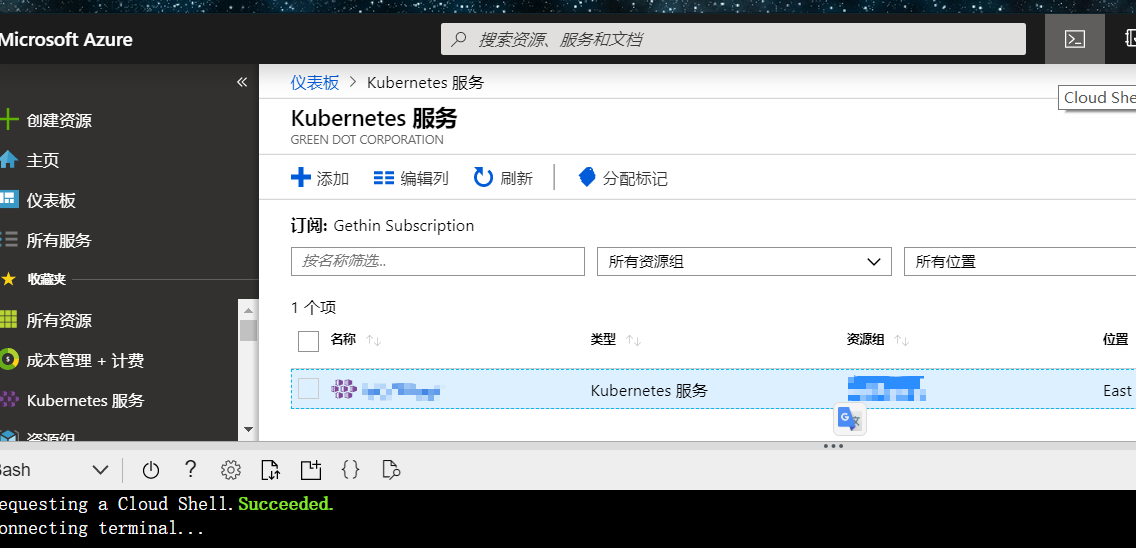How to setup kubernetes on Azure
This article try to record the steps for setting AKS and some components in Azure.
- Step 1. How to set AKS Cluster in Azure
- Step 2 Open the could shell
- Step 3 install Prometheus
- Step 4 install Grafana
- step 5 Access the Kubernetes web dashboard in AKS
- setp 6 install traekit
- step 7 install kubeapps
Step 1. How to set AKS Cluster in Azure
This step could reference the official documents as below, https://docs.microsoft.com/en-us/azure/aks/kubernetes-walkthrough-portal
Step 2 Open the could shell
 )
)
The link as https://shell.azure.com/
And input the Command as below
az aks get-credentials --resource-group AKSGroup --name AKSClusterStep 3 install Prometheus
How to create change nampspace :
kuebctl create ns monitoring
kubectl config set-context --current --namespace=monitoringThe install command as below,
helm install stable/prometheus --name kube-prometheus --set rbac.create=true --namespace monitoringIf you met the issue like
Error: namespaces "monitoring" is forbidden: User "system:serviceaccount:kube-system:default" cannot get resource "namespaces" in API group "" in the namespace "monitoring"
Solution: rbac-config.yaml
apiVersion: v1
kind: ServiceAccount
metadata:
name: tiller
namespace: kube-system
---
apiVersion: rbac.authorization.k8s.io/v1
kind: ClusterRoleBinding
metadata:
name: tiller
roleRef:
apiGroup: rbac.authorization.k8s.io
kind: ClusterRole
name: cluster-admin
subjects:
- kind: ServiceAccount
name: tiller
namespace: kube-systemkubectl create -f rbac-config.yaml
helm init --service-account tiller --history-max 200Step 4 install Grafana
helm install stable/grafana --set persistence.enabled=true --set persistence.accessModes={ReadWriteOnce} --set persistence.size=8Gi -n grafana --namespace monitoringYou can mark the service as LoadBalancer,
kubectl edit svc grafanaGet the password,
kubectl get secret --namespace monitoring grafana -o jsonpath="{.data.admin-password}" | base64 --decode ; echostep 5 Access the Kubernetes web dashboard in AKS
The shell script as below.
az aks browse --resource-group AKSGroup --name AKSClusterFor RBAC-enabled clusters.
kubectl create clusterrolebinding kubernetes-dashboard --clusterrole=cluster-admin --serviceaccount=kube-system:kubernetes-dashboardsetp 6 install traekit
install htpasswd.
apt-get install apache2-utilsgenerate password.
htpasswd -nbm admin password1234install traefik.
helm install stable/traefik --set dashboard.enabled=true,serviceType=LoadBalancer,rbac.enabled=true,dashboard.auth.basic.admin='$apr1$ZywpxeoS$6U80kYPG116slxBceEsVz0',dashboard.domain=traefik.dashboard --name=traefik --namespace=kube-systemhelm delete.
helm del --purge traefikstep 7 install kubeapps
1. Install Kubeapps.
kubectl create namespace kubeappshelm repo add bitnami https://charts.bitnami.com/bitnamiHelm 2 command
helm install --name kubeapps --namespace kubeapps bitnami/kubeappsHelm 3 command
helm install kubeapps --namespace kubeapps bitnami/kubeapps --set useHelm3=true2. Create a Kubernetes API token.
Create service account,
kubectl create serviceaccount kubeapps-operator -n kubeappsCreate cluster role binding,
kubectl create clusterrolebinding kubeapps-operator --clusterrole=cluster-admin --serviceaccount=kubeapps:kubeapps-operatorGet the secret,
kubectl get secret -n kubeapps $(kubectl get serviceaccount kubeapps-operator -n kubeapps -o jsonpath='{.secrets[].name}') -o jsonpath='{.data.token}' | base64 --decode && echo